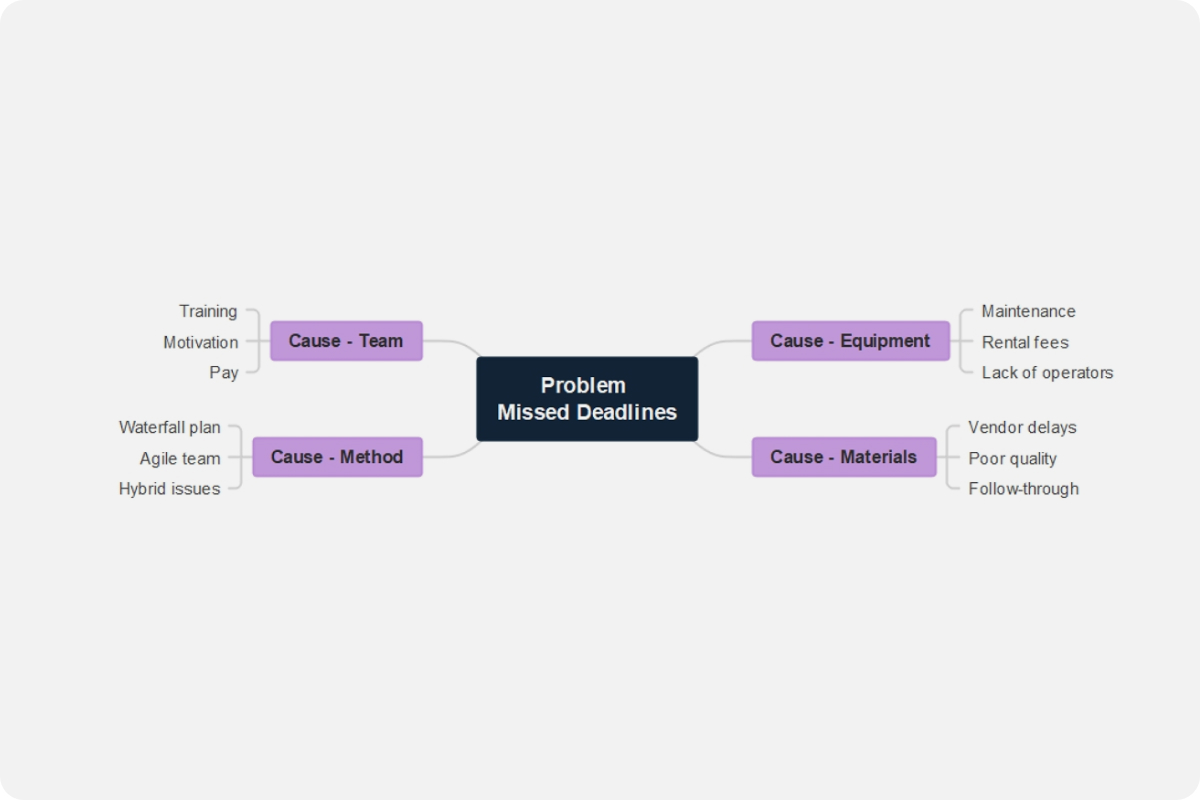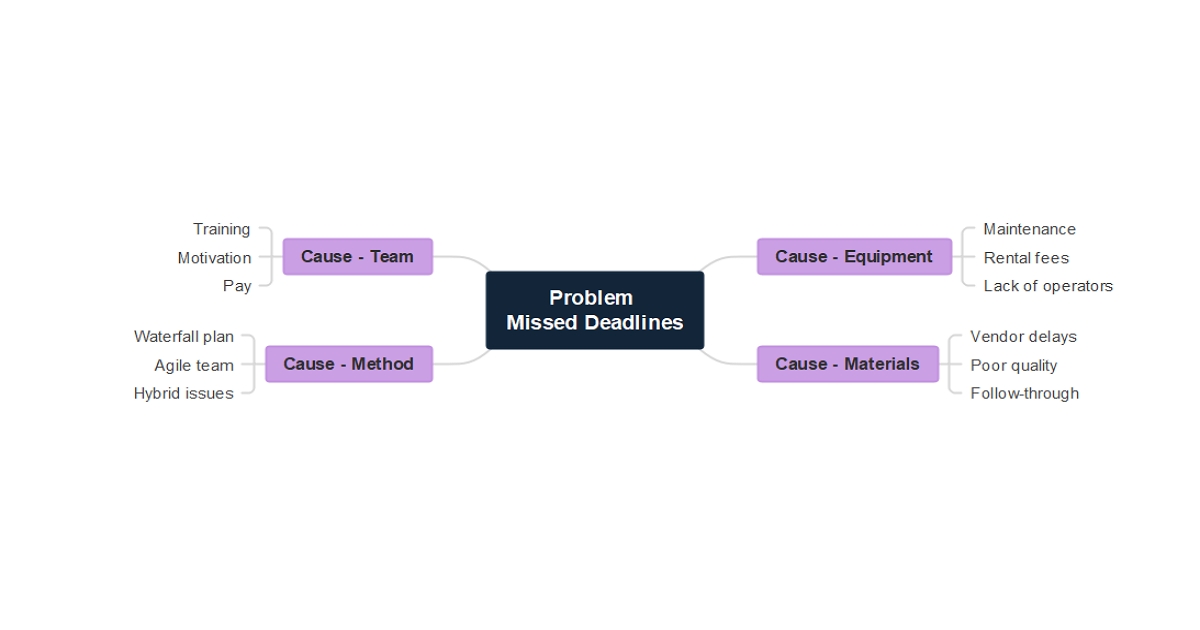About the Root Cause Analysis Template
A root cause analysis (RCA) is a technique for determining the root cause of an issue. There are numerous successful techniques for performing an RCA, but we'll utilize the fishbone diagram, which is also known as the Ishikawa diagram, in this checklist to assist dive deep and uncover root causes. When a problem or accident occurs, and the reason must be determined, a root cause analysis is done.
The procedures are taken to identify the problem and discover the cause are listed in the root cause analysis documentation, as well as the methodology that will be used to treat the problem and avoid it in the future. As part of the study, diagrams demonstrating cause-and-effect correlations may be included in the root cause analysis template.
Why conduct a root cause analysis?
Conducting a root cause analysis helps you to solve issues that are preventing your organization from succeeding. The visible concerns that are handled on a daily basis are rarely the root causes. A root cause analysis (RCA) identifies the roots of your company's reoccurring issues and aids in the development of a more effective plan to resolve them permanently.
Root Cause Analysis is a method for determining the source of an issue and resolving it. Determine what unfavorable occurrences are taking place. RCA is a critical analytical technique for conducting a complete, system-wide evaluation of major problems, as well as the events and causes that led to them.
Key principles of root cause analysis
- The basic goal of RCA is to discover the root cause of a problem, after which remedial steps and activities may be taken to assist eradicate the root cause of the defect.
- The fundamental objective of RCA is to identify the elements that contributed to the nature, amount, location, and time of one or more past events' negative effects. This is to establish which habits, actions, inactions, or situations must be altered to prevent similar adverse consequences from occurring in the future.
- Rather than just addressing the symptoms of a system failure, one should be highly focused on discovering and identifying remedial steps that need to be performed for a better and effective result.
- The investigation procedure is a highly important and crucial procedure. It necessitates the use of proper processes in order to get effective and accurate outcomes. Similarly, for better outcomes, the RCA process should be carried out with complete attention and strict adherence to procedures.
- The analysis should establish a chain of events or chronology to grasp the links between contributing (causal) variables, underlying cause(s), and the stated issue or occurrence to avoid in the future.
- Rather to focusing on who committed the mistake, the main focus should be on why the defect happened and what the principal cause of the fault is. Instead than focusing on who is to blame, the focus should be on how and why the fault happened.
How to conduct an effective root cause analysis?
The root cause is the underlying source of an issue, and if it is not discovered, the problem will most likely recur. The issue will only be permanently resolved if the fundamental cause has been identified and addressed. Your team can pick from a variety of root cause analysis methodologies depending on the nature, scope, and complexity of the problem.
Starting the root cause analysis with a step-by-step methodology and pre-made templates allows you to discover and understand the problem before moving on with its resolution in the root cause analysis template.
Step 1: Determine Potential Causal Factors
During the scenario analysis, the project team established the vision, identified the problem, and gathered data to better understand the current situation. This data may be used to find causative factors or things that cause or contribute to a health problem. Make a list of as many possible reasons as you can.
Begin with the problem and ask, "Why?" to generate a list of possible causes. A stakeholder workshop and a desk review done during the scenario analysis are ideal areas to look for causative variables.
Step 2: Figure out what's causing the problem
Start with the above-mentioned causative variables and inquire as to why, for example, "Why are couples not utilizing contemporary contraceptive methods?" Start with the causative variables listed above and ask why to discover root causes — the fundamental roots of the health condition. The most evident reasons are rarely the root causes. It's crucial to keep digging and asking "why?" until virtually all possible answers have been explored or roots that appear to be vital to address have been discovered. Identifying underlying causes may be done in a variety of ways.
The construction of a root cause tree is one approach for finding root causes. To receive a list of probable reasons, start with the problem and ask why. Connect them in a logical cause-and-effect chain until you find the problem's root. Your team members will discover the true reason, or root cause, why the problem happened in the first place after carefully evaluating the situation. They'll be able to find the true source of the problem by using a common root cause analysis template and methodologies like the 5 Whys or a Fishbone diagram.
Step 3: Get the ball rolling on the solution
The root cause is brought to the fore by employing a root cause analysis template. Now is the moment to fix the problem by deciding on the best course of action. To ensure that a solution is implemented effectively, make sure you have a problem-solving checklist that contains the participants, deadlines, processes, and criteria.
Step 4: Verify the results
Are the problem's corrective measures being performed, or is it being planned for a later date? Awesome! It's time to come to a halt and confirm if the issue has been entirely handled or will be remedied soon. For future reference, keep a record of the steps done and their effective consequences. Indicate if the answer was a complete fix or a partial fix to the team. If the partially resolved issue has the potential to influence other linked projects or team deliverables, your team will need to keep a close eye on it.
Root cause analysis tips
Do you want your team to be successful? Assist them in asking the appropriate questions that will get them closer to the answers. They can get closer to a potential solution and identify the core cause of an issue by asking the appropriate questions.
1, Collaborate as a team since having an extra pair of eyes is usually beneficial. The ultimate product is more comprehensive and gives a varied collection of options to pick from, in addition to reducing unintended biases.
2, Project the future because it's necessary to be present in the now, but it's also crucial to keep an eye on the larger picture. Maintain awareness of the process in the context of your unique scenario and future company requirements when doing a root cause analysis.
3, Examine team triumphs because, if team issues are scrutinized, shouldn't team successes be scrutinized as well? Root Cause Analysis is a fantastic approach for identifying what's working well in your company, determining the main cause, and ensuring that additional successes follow. In reality, by studying the fundamental causes of achievements, your team may improve procedures so that these victories occur more frequently and across the board.
Root Cause Analysis Example
For example, a broken wrist cause severe pain, but medicines can just ease the pain, not restore the wrist; you will need a separate treatment to help the bones mend properly. The issue in this situation is a broken wrist, with wrist pain as a symptom and shattered bones as the core cause. The pain will not go away until the bones are healed.


